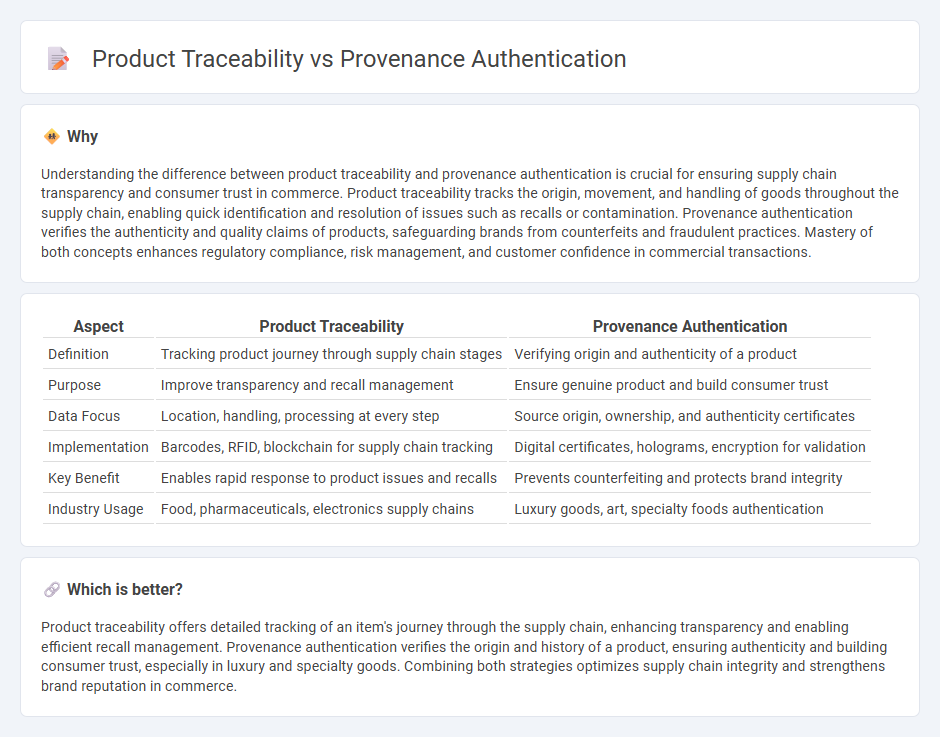
Product traceability tracks each stage of a product's journey through the supply chain, ensuring transparency and accountability from raw materials to final delivery. Provenance authentication verifies the product's origin and authenticity, providing consumers with confidence in quality and ethical sourcing. Explore how integrating these systems can enhance trust and compliance in commerce.
Why it is important
Understanding the difference between product traceability and provenance authentication is crucial for ensuring supply chain transparency and consumer trust in commerce. Product traceability tracks the origin, movement, and handling of goods throughout the supply chain, enabling quick identification and resolution of issues such as recalls or contamination. Provenance authentication verifies the authenticity and quality claims of products, safeguarding brands from counterfeits and fraudulent practices. Mastery of both concepts enhances regulatory compliance, risk management, and customer confidence in commercial transactions.
Comparison Table
| Aspect | Product Traceability | Provenance Authentication |
|---|---|---|
| Definition | Tracking product journey through supply chain stages | Verifying origin and authenticity of a product |
| Purpose | Improve transparency and recall management | Ensure genuine product and build consumer trust |
| Data Focus | Location, handling, processing at every step | Source origin, ownership, and authenticity certificates |
| Implementation | Barcodes, RFID, blockchain for supply chain tracking | Digital certificates, holograms, encryption for validation |
| Key Benefit | Enables rapid response to product issues and recalls | Prevents counterfeiting and protects brand integrity |
| Industry Usage | Food, pharmaceuticals, electronics supply chains | Luxury goods, art, specialty foods authentication |
Which is better?
Product traceability offers detailed tracking of an item's journey through the supply chain, enhancing transparency and enabling efficient recall management. Provenance authentication verifies the origin and history of a product, ensuring authenticity and building consumer trust, especially in luxury and specialty goods. Combining both strategies optimizes supply chain integrity and strengthens brand reputation in commerce.
Connection
Product traceability relies on detailed tracking systems that record each stage of a product's lifecycle, ensuring transparency and accountability from origin to consumer. Provenance authentication verifies the authenticity and source of a product by cross-referencing traceability data with certified records, preventing fraud and counterfeiting in commerce. Together, they enhance supply chain integrity, build consumer trust, and comply with regulatory standards in global trade.
Key Terms
Source Verification
Provenance authentication centers on verifying the origin and authentic history of a product through immutable records, ensuring its legitimacy and preventing counterfeiting. Product traceability involves tracking the product's journey across the supply chain, documenting every stage from raw material to final delivery for quality control and regulatory compliance. Explore more to understand how source verification enhances trust and transparency in supply chains.
Supply Chain Tracking
Provenance authentication involves verifying the origin and history of a product to ensure its authenticity, using technologies like blockchain and digital fingerprints. Product traceability tracks the entire lifecycle of a product through the supply chain, enabling real-time monitoring from raw materials to end consumers with systems such as RFID and QR codes. Explore the latest innovations in supply chain tracking to enhance both provenance authentication and product traceability.
Chain of Custody
Provenance authentication verifies the origin and history of a product, ensuring its authenticity through secure documentation, while product traceability tracks the movement and transformation of products throughout the supply chain. Chain of Custody acts as a critical link in both processes by maintaining a transparent, verifiable record of ownership transfers from source to final consumer. Explore how integrating Chain of Custody enhances supply chain integrity and consumer trust.
Source and External Links
How Digital Provenance Preserves Image Integrity and Security - Provenance authentication is a sophisticated record-keeping system that tracks a digital asset's lifecycle, establishing origin, modification history, and authenticity to ensure the asset is unaltered and verifiable throughout its use and sharing.
How to Authenticate Provenance and History - Provenance authentication combines provenance research, scientific analysis, expert opinion, and emerging technologies like blockchain and AI to securely verify an artwork or asset's origin, ownership history, and authenticity.
Provenance and Verification in AI-Generated Media - Provenance authentication traces the origin, creation process, ownership, and modifications of digital media, enabling reliable verification of its authenticity by embedding metadata and maintaining transparent records.
 dowidth.com
dowidth.com